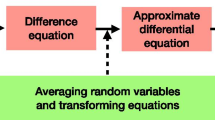Abstract
In various real-world networks, the set of nodes is partitioned in groups or types forming densely connected clusters commonly called ‘communities’. Several methods have been developed to find community structure in networks; one of them is based on modularity, a measure that represents the fraction of edges between nodes of the same type minus the expected fraction of such edges if they are established by a random process. Our work introduces a dynamic generation model of directed heterogeneous networks in which the set of nodes is partitioned in two groups. Networks based on our model grow by the addition of new nodes and the creation of new edges at each instant of time according to the combination of two mechanisms: (i) affinity-weighted preferential attachment and (ii) reciprocity response. We characterise the dynamics and limit values for the sum of the in- and out-degree of the nodes of the network which help us to determine the tail of the degree distributions (in and out) for each type of nodes. We show that both distributions follow a power law with equal scaling exponent. Using the limit values associated with the degree properties of our networks, we derive the dynamics and the asymptotic behaviour of the directed network modularity and establish conditions to guarantee the occurrence of communities according to the type of nodes.







Similar content being viewed by others
References
M Newman, D Watts and S Strogatz, Proc. Natl Acad. Sci. 99, 2566 (2002)
A-L Barabási and R Albert, Science 286, 509 (1999)
G Bianconi and A-L Barabási, Europhys. Lett. 54, 436 (2001)
K Guerrero and J Finke, Proc. Conf. Decision Control 2318 (2017)
K Growiec, J Growiec and B Kamiński, Social Networks 55, 31 (2018)
P Moriano and J Finke, Europhys. Lett. 99, 18002 (2012)
H Simon, Biometrika 42, 425 (1955)
D-S Lee, K-I Goh, B Kahng and D Kim, Pramana – J. Phys. 64, 1149 (2005)
X Zhang and Q Zhao, Pramana – J. Phys. 74, 469 (2010)
M Henzinger and S Lawrence, Proc. Natl Acad. Sci. 101, 5186 (2004)
F Fabbri, F Bonchi, L Boratto and C Castillo, Proc. Int. AAAI Conf. Web Social Media 14, 165 (2020)
F Karimi, M Génois, C Wagner, P Singer and M Strohmaier, Sci. Rep. 8, 1 (2018)
C Avin, H Daltrophe, B Keller, Z Lotker, C Mathieu, P Peleg and Y-A Pignolet, Physica A 555, 124723 (2020)
M McPherson, L Smith-Lovin and J Cook, Ann. Rev. Sociol. 27, 415 (2001)
K Kim, J Altmann, L Smith-Lovin and J Cook, Commun. Nonlinear Sci. Numer. Simulat. 44, 482 (2017)
M Grandjean, Cogent Arts Humanities 3, 1171458 (2016)
A Traud, P Mucha and M Porter, Physica A 391, 4165 (2012)
Y Liu, B Wei, Y Du, F Xiao, Y Deng, P Mucha and M Porter, Chaos Solitons Fractals 86, 1 (2016)
D Ruiz, J Campos and J Finke, J. Stat. Phys. 181, 673 (2020)
V Ciotti, M Bonaventura, V Nicosia, P Panzarasa and V Latora, EPJ Data Sci. 181, 673 (2020)
F Riquelme and P González-Cantergiani, Inform. Process. Manage. 52, 949 (2016)
A Clauset, M Newman and C Moore, Phys. Rev. E 70, 066111 (2004)
S Fortunato, Phys. Rep. 486, 75 (2010)
N Dugué and A Pérez, Directed Louvain: Maximizing modularity in directed networks, Technical Report (Université d’Orléans, 2015)
E Leicht and M Newman, Phys. Rev. Lett. 100, 118703 (2008)
N Dugué and A Pérez, Physica A 603, 127798 (2022)
E Lee, F Karimi, C Wagner, H-H Jo, M Strohmaier and M Galesic, Nature Human Behaviour 10, 1078 (2019)
D Ruiz, Int. J. Appl. Math. 34, 1187 (2021)
Acknowledgements
This research was supported in part by the Universidad del Cauca, under research project VRI ID 5681.
Author information
Authors and Affiliations
Corresponding author
Rights and permissions
About this article
Cite this article
Murcia, A., Pérez, N. & Ruiz, D. Dynamics and asymptotic behaviour of directed modularity in heterogeneous networks. Pramana - J Phys 97, 142 (2023). https://doi.org/10.1007/s12043-023-02608-y
Received:
Accepted:
Published:
DOI: https://doi.org/10.1007/s12043-023-02608-y




